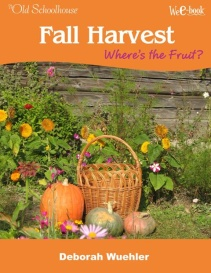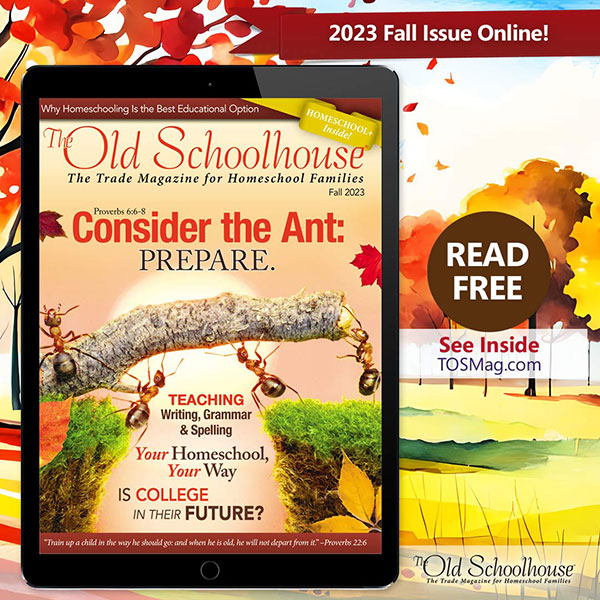October 4, 2023 – Is Internet Learning a Good Thing? What Are My Options?


Is Internet Learning a Good Thing? What Are My Options?
October 4, 2023
Deborah Wuehler
Delight or Danger?
Stacy Farrell
Right at Your Fingertips
Sherri Seligson
The Internet: A Good Source for Education?
Diane Heeney
Balancing Technology in the Homeschool
| Be sure to scroll to the bottom to enter the contest and see the freebies of the month! |

Mercy Every Minute
Deborah Wuehler, TOS Senior Editor
Delight or Danger?
When I am at a loss of what to teach or how to teach it, I often look for help online. Online learning, tutoring, and apps can be very helpful in our homeschooling and there are so many delightful options. Personally, half of my high schooler’s courses are online or are digital courses this semester.
However, the internet can also be a foe in our homeschool if we are not careful, especially if used for recreation, socializing, or boredom. The draw for our virtual attention can be great. It is not that we don’t trust our children, it is that we don’t trust what can pop up virtually. Some safeguards are:
- Parents have filters and parental controls in place and check filter reports regularly.
- If schoolwork calls for computer usage, know when and where so that it can be safely monitored.
- Computers, phones, tablets, etc. are to be used in an open area, and not hidden away.
- Time limits are placed on computer/phone/tablet usage.
In our home, if there had been too much electronic activity that day already, i.e., they watched a video or played a game, etc., then no more virtual activity until they have done something productive, creative, hands-on, physical, or chore related.
Even for parents, we all know that five minutes online or on our phones leads to twenty, and then before you know it, we’ve clicked our way into frustration as everything else piles up around us. Internet use can be a delight or a danger, so we must proceed cautiously and with wisdom.
God gifted you with these children, and He will equip you. You are not a failure. You have a Faithful God writing your story. He will complete the work He begins.
“My flesh and my heart fail, but God is the strength of my life . . .” Psalm 73:26
~ Deborah
Beyond the Dining Room Table: The Amazing Benefits of Online Learning, by Cheri Blomquist

Stacy Farrell
Right at Your Fingertips
Back in the day, I accessed the internet via a dial-up modem that screeched and squeaked its way onto the world wide web. It seemed to take forever. Once it finally made a connection, if someone picked up the phone to make a call, that internet connection was lost.
We’ve come a long way from “back in the day.”
With fiber optics, 5G, and lightning-fast connections—the internet has woven itself into the very fabric of our daily lives.
Blessings Abound
The web has become an indispensable tool, reshaping the homeschooling experience in ways we could have scarcely imagined a decade ago.
Now a world of learning is at our fingertips.
Teaching your students to write? With just a few clicks, you can find helpful posts like:
- Fun Creative Writing Topics and Prompts for Third Grade
- Persuasive Writing Examples and Prompts for Kids
- 20 Picture-Based Writing Prompts and Ideas for Kids
- 9 Powerful Ways to Start an Essay That Positively Impacts Readers
- 55 One-Sentence Writing Prompts to Kickstart Your Student’s Stories
Want to help your students develop critical thinking skills and learn how to be persuasive? A few more clicks and you can land on:
- 240 Philosophical Questions for Deep Critical Thinking & Debate
- How can we help our children become critical thinkers?
- 150 Good Argument Topics for Essays
Danger in Our Midst
But with the blessing of easy access comes certain pitfalls:
- Overwhelming Information: There is so much information available, it’s easy to get analysis paralysis.
- Digital Distractions: Raise your hand if you’ve ever lost hours to the black hole of social media or a clickbait article (guilty as charged)!
- Safety & Reliability Concerns: The internet’s vastness means there’s content that might not be age-appropriate or appropriate for any age!
In the grand tapestry of homeschooling, the internet is a colorful thread. It’s brought unparalleled resources and community right to our fingertips.
Yet, like many tools, it requires a measured approach.
By setting boundaries, attentively checking in on our children’s online activities, and intentionally unplugging on a regular basis, we can enjoy the best the web has to offer—without getting snared in its sticky strands.
His love,
Stacy
Grab this Freebie! What if your students could decrease their study time, but retain more information and improve their grades? It’s possible with the right habits. Discover ten strategic habits to more effective studying today!
About the author
Surprised by Jesus, Stacy went from an unmarried, childless, thirty-something career woman to a Christ-following wife of more than twenty-eight years with two sons she homeschooled K-12. She battled fear and overwhelm, but survived and thrived. Author of more than fifteen books—including the award-winning Philosophy Adventure and newly released Food Prep Guide, she loves to equip and encourage homeschool families. Visit her at HomeschoolAdventure.com or at her newly-launched site: FoodPrepGuide.com.

Sherri Seligson
The Internet: A Good Source for Education?
Using the Internet as an educational tool has been a topic of concern for parents ever since computers were first brought into the home. And since 2020, homeschoolers have been overwhelmed with increasing choices of virtual learning, online classes, and even YouTube instruction. Is all this good?
Well, yes. And no.
Virtual learning can be a useful tool. A short video animation of the water cycle might help your child better understand a process that can’t be easily explained with a dialogue or a couple images. Difficult-to-grasp concepts, such as converting fractions to percentages might overwhelm Mom or Dad, but they will be easily explained by an online math tutor. Watching someone walk the site of an ancient battle might bring history to life in a way that a textbook cannot. And virtual classrooms can provide organization, instruction, accountability, and even grading!
However, the Internet can be a quicksand of diving deeper and deeper into topics that drift from an original search. It is open to others’ worldviews and potential connections with individuals who might have less-than-positive motives for your children. We need to protect them from these concerning issues.
Frankly, using Internet learning is a decision that will vary from one family to another. It may even be different for each child in your home. I suggest that you prayerfully consider what sites and virtual contacts you let into your home. If there is a class you are interested in, look at the company’s statement of faith and the reviews. Preview as much as you can. Keep your children’s computer use in the public spots in your home so there is always visual accountability.
And most importantly, have frank conversations with your children so they are aware of both the dangers and blessings of this tool. They should be learning how to navigate this issue while they are under your wisdom and influence so they are prepared to make wise decisions when they grow up.
About the author
Sherri Seligson, M.Ed. is a 21-year homeschool mom, marine biologist. Authoring Apologia’s science courses, instructional videos, and more, Sherri loves encouraging moms and teaching families the wonders of God’s creation. www.facebook.com/SherriSeligsonAuthor

Pillar of Faith

Diane Heeney
Balancing Technology in the Homeschool
The Bible teaches balance, and balance is critical when it comes to computer learning. We live in a technological age. Teaching our kids responsible stewardship of time and resources is as important as helping them become tech savvy.
We’ve done various approaches in our home education, ranging from physical books only, to completely online. Here are some observations we’ve made:
- Teaching online safety/discernment is a must (Psalm 101:3).
- Phones should not be allowed during school, meals, or family time.
- It’s wise to teach typing with correct form and grammar usage, using an actual keyboard. Kids think if they can text, they know how to type, which is not necessarily true.
- Screen learning should be balanced with physical learning materials and activities like using actual books, doing experiments, and creating art.
- Alternating screen time with human interaction and outdoor activity is healthful.
- Having a way to monitor online activity is imperative.
- Blue blocking apps/glasses curb the negative effects of blue/green/ultraviolet light.
- Late night learners (my teens always preferred studying in the evening) should complete screen lessons at least two hours before bed.
- Modeling healthy, balanced use of technology as parents is vital . . . so have everyone unplug and go for a walk, garden, or bake some cookies together!
Diane Heeney is a graduate of Bob Jones University, where she served on the faculty for ten years. She has been Assistant to the Director of Advertising Sales at The Old Schoolhouse® Magazine since 2016. She’s homeschooled her three children over the course of the past eighteen years, having graduated their two oldest. Diane, her husband Patrick, and their youngest child, Katie, reside in eastern Wyoming.
A division of The Old Schoolhouse®

SchoolhouseTeachers.com Corner
Did you know?
Every class is INCLUDED for ultimate members!
No limits.
Do you struggle to organize your thoughts on the computer? Using Microsoft Word efficiently is a skill that most people will find very useful. With How to Get Started with Microsoft Word, you will learn how to use the advanced features of Microsoft Word, going beyond the “typewriter” level to utilize the tools that are available in this software to create professional-looking documents with ease.


Trying to balance online and offline learning in your homeschool? Online learning options are incredibly valuable when implemented properly, and balance is key. In Episode 36 of the Hey, Mama! Homeschool Show: Is Internet Learning a Good Thing? Heather discusses this topic with valuable insight from Cailin Sandvig of Homeschool Plus. Find the show notes on HomeschoolShow.com.

There are several ways to get a look under the hood of a college before signing on the dotted line. Find out how in this article by homeschool mom of six Linsey Knerl. (Find all the articles with HomeschoolApp.com.)
Start the school year off with The Old Schoolhouse® Magazine on hand. The Fall issue is easy to find. It’s on the TOS App now along with dozens of back issues full of timeless topics, and it’s all free. Read up on higher ed prep and college alternatives, foreign exchange students and foreign language study, adaptive technology, and more. Help is on hand wherever your homeschool takes you. HomeschoolApp.com. Here’s another place to find the Fall issue (and years of back issues): our Digital Magazine Library. Read free here too. New issues every quarter.
Contest Corner
for the month of October
Studio Art: Inspired by Art History

The Master and His Apprentices
https://TheMasterAndHisApprentices.com
Providing art curriculum from a Christian perspective, The Master and His Apprentices offers a unique learning experience. Between its two courses, Studio Art: Inspired by Art History is the core curriculum. Studio Art: Inspired by Art History is a self-paced, independent course that begins with ten foundational principles of art and concludes with thirty period specific projects.
Students learn value, lighting, texture, composition, perspective, proportions & grids, transferring, color, and sculpture before diving into exploring the people, places, world events, and incredible art that has been left behind throughout time. Students will have the opportunity to explore a variety of mediums and artistic styles as well as develop their art technique and creative approach. The students will create sea-inspired vases reminiscent of Aegean art and manuscript illuminations from the Proto-Renaissance Art Period. These are just two examples of the period projects students will complete.
Guidance is also provided to parents. There is a critique form in The Master and His Apprentices in Studio Art: Inspired by Art History with ten questions for the parent to answer. A question on the form asks, “Do the medium and style fit the chosen subject matter, period inspiration, and/or theme? If not, why?” Due to the subjective nature of art, grading will also be subjective. Grading tips are provided in the section “Instructions for Classroom Teachers and Homeschool Parents.” Project length is also discussed. The project length will vary because this curriculum is self-paced, and each student has their own ability. Typically, projects take four to five hours to complete. Some projects take much less time while others take much longer. In addition to this information, all necessary supplies, modifications, etc. are thoroughly outlined in the book.
This is part of a review of the course Studio Art: Inspired by Art History. Read the full review on our site which includes more details about the content.
Go to the contest page of our site where you can ENTER TO WIN the digital version of the course Studio Art: Inspired by Art History.
Freebies

Fall Harvest: Where’s the Fruit?
Is your cornucopia empty? Why doesn’t your family exhibit the kind of fruit you’d expect to see? What kind of seeds are you sowing?
These are questions that Deborah asked herself. She tells us: “Seasons change in our lives, the weather changes in our circumstances, and what grows in each season is different too—not only for us, but for our children as well.”
Gain new insight regarding the seasons of your lives and the developing harvest that’s possible in each of us as you read the WeE-book™. . .
Fall Harvest: Where’s the Fruit? By Deborah Wuehler Where is the fall harvest of God’s goodness and righteousness in your heart and in your house? Go through each season/stage of development with the author as she shares her wisdom and experiences of what she has learned, and you’ll see a pattern of things to be doing (or not doing) to ensure a good harvest in your children’s lives and in your own heart. She promises to show you something optimistic and hopefully even beautiful.
In the pages of this WeE-book™, you’ll find an abundance of wisdom, inspiration, and support:
- Where’s the Fruit in the Very Young?—We’ve sown into them day in and day out; when will we reap or even see any bounty? Prepare the soil; harvest time will come!
- Overestimating—A true story illustrating what can happen if you overestimate. Don’t let your child fall through the cracks.
- Underestimating—Become intentional in the things you pour into your child. They are capable of learning so much!
- Lazy Weeding—Faithfully and diligently “weed” that rich soil and be delighted with the outcome.
- Where’s the Fruit in the Elementary Years?—Learn from Sandy’s wasted corn patch. When the soil is ready, water the hearts of your children.
- Where’s the Fruit Entering the Teen Years?—Is there a purpose for these turbulent years? Transforming hearts with God’s Word.
- Where’s the Fruit in the Higher Education Years?—This teen-to-adulthood season is finally producing a visible harvest—and it’s delightful!
- Where’s the Fruit in Us?—Don’t just have the appearance of fruit in your life. Be fruitful and useful to the Planter!
- Death Brings Forth Life—Die to become beautiful. Discover a precious promise from God’s Word.
“May we be faithful to water our plants with Jesus, who is the Living Water, and in doing so, may we produce a harvest of much fruit.” —Deborah Wuehler
Ensure a good harvest in your children’s lives!
Homeschooling the Rebel Expo- Deb Wuehler
Hear from Deborah Wuehler as she shares on how she homeschooled her rebel and hear from the rebel herself – Hannah Wuehler!
Click on the image to watch the video!
Share this newsletter with a friend, and be sure to let those CONSIDERING homeschooling know about the enormous FREE info-pack which awaits them here: www.TryHomeschooling.com.
| We Want Your Feedback! |
| If you liked today’s Homeschool Minute, please email the editors and tell us what part you liked most. It’s a huge blessing to receive feedback! Please add publisher@theoldschoolhouse.com to your email contacts so that our emails to you don’t land in spam. |
DISCLAIMER: The Old Schoolhouse® and its staff do not necessarily endorse or agree with the articles, images, advertisements, or other content appearing in The Homeschool Minute, on any linked website, or otherwise. The views and opinions or other matters expressed in this newsletter are not necessarily those of the publishers, editors, staff, contractors, associates, or other affiliates of The Old Schoolhouse®





